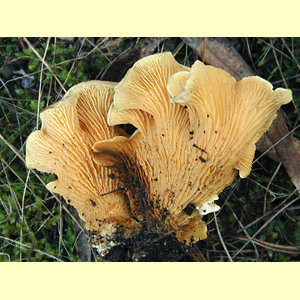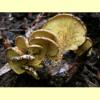


_AH_08_sml.jpg)
Meiorganum agathidis (= Merulius) from peninsular Malaysia and Borneo, which has dextrinoid spores, could also belong in Tapinella if the reaction in Melzer's reagent proves to be decisive in the distinction from Meiorganum.
Crepidotus prostratus (see under Crepidotus (smooth spores)) could belong in Tapinella.
Bougher, N. & Syme, K. (1998), Fungi of Southern Australia. University of Western Australia Press, Nedlands. [Description, Illustration and Microcharacters of T. panuoides]
Breitenbach, J. & Kränzlin, F. (eds) (1991), Fungi of Switzerland. Volume 3. Boletes and Agarics 1st part. Edition Mykologia, Lucerne. [Illustration, Description and Microcharacters of T. panuoides from Europe]
Corner, E.J.H. (1971), Merulioid fungi in Malaysia, Gard. Bull. Singapore 25: 355–381. [Description, Illustration and Microcharacters of Meiorganum agathidis, as Merulius, which may belong in Tapinella, and seems close to the Australian Tapinella aff. panuoides]
Fuhrer, B. (2005), A Field Guide to Australian Fungi. Bloomings Books, Hawthorn. [Description and Illustration of T. panuoides]
Grgurinovic, C.A. (1997a), Larger Fungi of South Australia. The Botanic Gardens of Adelaide and State Herbarium and The Flora and Fauna of South Australia Handbooks Committee, Adelaide. [Description and Microcharacters of T. panuoides]
Hood, I.A. (2003), An Introduction to Fungi on Wood in Queensland. University of New England, School of Environmental Sciences and Natural Resources Management, Armidale. [Description and B&W Illustration of T. panuoides (as Paxillus)]
McCann, I.R. (2003), Australian Fungi Illustrated. Macdown Productions, Vermont. [Illustration of T. panuoides]
Reid, D.A. (1956), New or interesting records of Australasian Basidiomycetes, Kew Bull. 1955: 631–648.[Brief Description, and Microcharacters of Tapinella aff. panuoides (as Paxillus)]
Singer, R., Garcia, J. & Gomez, L.D. (1990), The Boletineae of Mexico and Central America I & II, Beih. Nova Hedwigia 98: 1–70. [Description and Microcharacters of T. panuoides from Mexico]
Watling, R. & Gregory, N.M. (1991), Observations on the boletes of the Cooloola sandmass, Queensland and notes on their distribution in Australia. - Part 3: lamellate taxa, Edinburgh J. Bot. 48: 353–391. [Discussion on T. panuoides in Australia].
